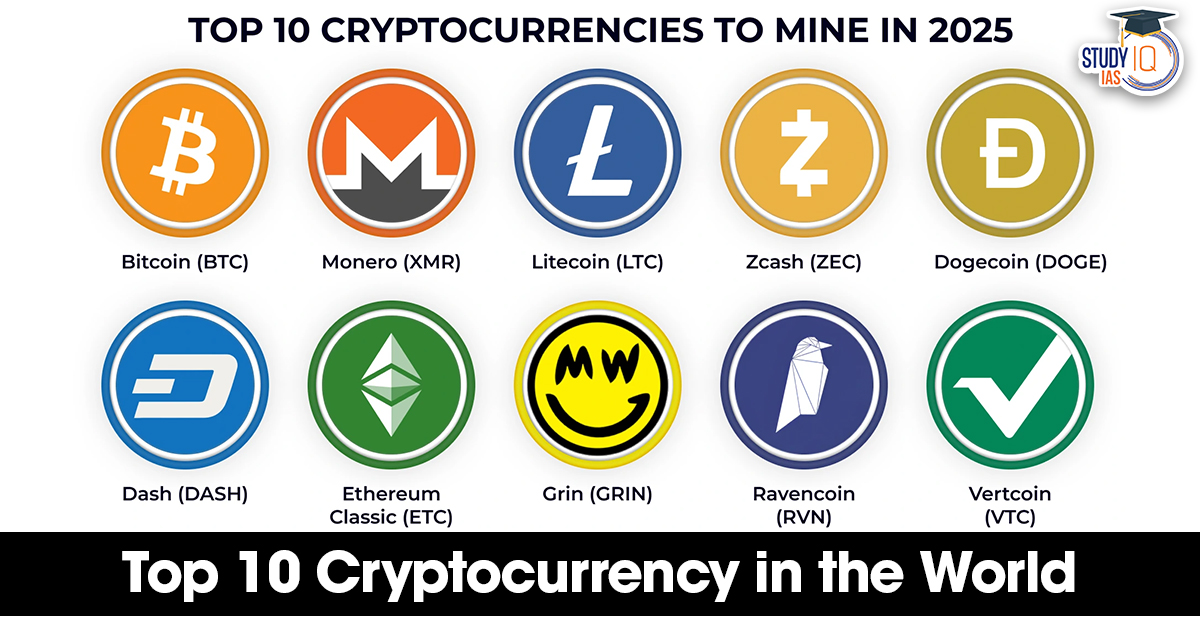Table of Contents
The cryptocurrency market in 2025 is not merely a speculative zone — it’s a dynamic financial ecosystem influencing global finance, policy, and innovation. From decentralized finance (DeFi) to global remittances and tokenized assets, crypto assets are rapidly transforming how the world transacts and invests.
With a total market capitalization of $3.09 trillion, cryptocurrencies are now serious contenders in shaping the future of finance. Let’s dive into the Top 10 Cryptocurrencies in the World by Market Cap in 2025, analyzing what sets them apart in terms of utility, adoption, and growth.
Key Market Trends: Cryptocurrency in 2025
The cryptocurrency market has experienced explosive growth over the last decade. The beginning of 2025 saw Bitcoin reaching an all-time high of $107,000, only to stabilize at $1.92 trillion in market cap due to external factors such as global tariff tensions and regulatory changes. However, a 90-day suspension of tariffs announced by former U.S. President Donald Trump in early April 2025 contributed to a market surge and greater confidence in digital currencies.
Cryptocurrencies like Ethereum, Tether, and Solana have now become part of mainstream financial systems, with the global user base growing to an estimated 861 million people. The global cryptocurrency market revenue is forecasted to reach $45.3 billion in 2025, further solidifying the growing relevance of these digital assets.
Top 10 Cryptocurrencies by Market Cap – As of May 2025
| Rank | Name | Symbol | Market Capitalization (USD) |
|---|---|---|---|
| 1 | Bitcoin | BTC | $1.92 Trillion |
| 2 | Ethereum | ETH | $220.86 Billion |
| 3 | Tether | USDT | $149.41 Billion |
| 4 | XRP | XRP | $125.82 Billion |
| 5 | BNB (Binance Coin) | BNB | $87.87 Billion |
| 6 | Solana | SOL | $75.98 Billion |
| 7 | USD Coin | USDC | $60.97 Billion |
| 8 | Dogecoin | DOGE | $25.69 Billion |
| 9 | Cardano | ADA | $24.51 Billion |
| 10 | TRON | TRX | $23.14 Billion |
Top 10 Cryptocurrencies by Market Cap in 2025
1. Bitcoin (BTC)
-
Market Cap: $1.92 trillion
-
All-Time High (2025): $107,000
-
Overview: Bitcoin continues to reign as the king of cryptocurrencies, with a market cap nearly double that of the second-largest cryptocurrency, Ethereum. Often referred to as digital gold, Bitcoin’s primary appeal is its scarcity—the total supply is capped at 21 million coins. Bitcoin has become a store of value for institutional investors, and its popularity surged in 2025 due to growing institutional investments, ETF approvals, and increasing adoption among major financial entities.
Key Factors Driving Growth:
-
Deflationary nature due to limited supply.
-
Institutional backing, including investments from Tesla, MicroStrategy, and others.
-
Enhanced global adoption in countries like El Salvador, where Bitcoin is used as legal tender.
Use Cases:
-
Store of value (hedge against inflation).
-
Digital currency for cross-border transactions.
-
Investment asset for institutions and retail investors.
-
2. Ethereum (ETH)
-
Market Cap: $220.86 billion
-
All-Time High (2025): $4,800 (approx.)
-
Overview: Ethereum is the leading blockchain platform for smart contracts, decentralized finance (DeFi), and NFTs. Ethereum’s widespread adoption in various sectors, from finance to gaming, has helped it solidify its position as the second-largest cryptocurrency by market capitalization.
Ethereum 2.0 Upgrade:
-
Ethereum has been undergoing a transition from Proof of Work (PoW) to Proof of Stake (PoS) to improve scalability, security, and energy efficiency.
-
Sharding technology in Ethereum 2.0 will allow for better data handling and faster transaction speeds.
Use Cases:
-
Smart contracts in decentralized applications (dApps).
-
Foundation for DeFi platforms.
-
NFT marketplaces like OpenSea and Rarible.
-
3. Tether (USDT)
-
Market Cap: $149.41 billion
-
Overview: Tether (USDT) is the most popular stablecoin in the crypto market, designed to maintain a stable value by being pegged 1:1 to the U.S. dollar. Tether is widely used as a trading pair on exchanges and is essential for providing liquidity to the market.
Why Tether is Important:
-
Tether’s stability makes it ideal for short-term trading and portfolio diversification.
-
USDT enables institutional investors to move between crypto and fiat without volatility risks.
Use Cases:
-
Currency peg: Acts as a stable store of value during market volatility.
-
Trading liquidity: Used by exchanges for transactions and arbitrage.
-
Cross-border payments in emerging markets where traditional banking is underdeveloped.
-
4. XRP
-
Market Cap: $125.82 billion
-
Overview: XRP, created by Ripple Labs, has carved out its niche in the world of cross-border payments. Unlike Bitcoin, which is mainly a store of value, XRP focuses on speed and efficiency for large-scale financial transactions.
XRP in the Financial World:
-
XRP is designed to facilitate instant international payments at low cost.
-
Ripple has partnered with various global banks and financial institutions to enhance the remittance market.
Use Cases:
-
Cross-border payment solutions for banks and institutions.
-
Fast and low-cost transactions between countries.
-
Tokenized assets for trading and settlement.
-
5. BNB (Binance Coin)
-
Market Cap: $87.87 billion
-
Overview: BNB is the native token of the Binance exchange, the largest cryptocurrency exchange in the world. Initially launched as a utility token to pay for trading fees, BNB’s use case has expanded into DeFi, NFTs, and other blockchain applications.
Key Factors Driving Growth:
-
Binance Smart Chain (BSC): A high-performance blockchain enabling fast and cheap transactions for dApps.
-
Staking and Governance: BNB holders can participate in the governance of the Binance ecosystem.
Use Cases:
-
Trading fee discounts on Binance.
-
Gas fees on Binance Smart Chain.
-
NFT platforms and DeFi protocols.
-
6. Solana (SOL)
-
Market Cap: $75.98 billion
-
Overview: Solana has emerged as a top competitor to Ethereum due to its high-speed, low-cost transactions. Solana’s blockchain can handle up to 65,000 transactions per second (TPS), making it an attractive choice for developers looking for faster alternatives to Ethereum.
Use Cases:
-
Decentralized finance (DeFi) applications.
-
NFT marketplaces and gaming platforms.
-
Payments and microtransactions.
-
7. USD Coin (USDC)
-
Market Cap: $60.97 billion
-
Overview: USDC is another stablecoin, pegged to the U.S. dollar, designed for more transparent and regulated transactions. It is fully backed by U.S. dollar reserves and is widely used across the crypto ecosystem.
Use Cases:
-
Cross-border transactions with regulatory clarity.
-
Storing value with minimal volatility.
-
Smart contracts and DeFi applications on platforms like Ethereum.
-
8. Dogecoin (DOGE)
-
Market Cap: $25.69 billion
-
Overview: Originally created as a joke, Dogecoin has evolved into one of the most popular cryptocurrencies. With strong community backing and endorsements from figures like Elon Musk, Dogecoin has become a cultural phenomenon.
Use Cases:
-
Tipping and donations on social media.
-
Transaction fees in various online platforms.
-
Memes and cultural relevance.
-
9. Cardano (ADA)
-
Market Cap: $24.51 billion
-
Overview: Cardano is an academic-driven blockchain designed for smart contracts, offering peer-reviewed research as the foundation for its decentralized applications.
Key Features:
-
Proof of Stake (PoS): A more energy-efficient alternative to PoW.
-
Ongoing upgrades to increase scalability and enhance smart contract functionality.
Use Cases:
-
Smart contracts and dApps.
-
Supply chain and voting systems.
-
Healthcare and government solutions.
-
10. TRON (TRX)
-
Market Cap: $23.14 billion
-
Overview: TRON focuses on content-sharing platforms and entertainment, offering high scalability and low transaction costs.
Use Cases:
-
Decentralized content platforms.
-
Entertainment ecosystems and gaming.
-
Cross-chain interoperability for various blockchain applications.
-
Conclusion
The top 10 cryptocurrencies of 2025 reflect a blend of utility, stability, scalability, and community-driven adoption. As the world embraces digital assets, these cryptocurrencies will continue to influence global markets, policy discussions, and technological innovation.


 Meerut Bugle Gets GI Tag 2025: The 150-Y...
Meerut Bugle Gets GI Tag 2025: The 150-Y...
 Reforming State Public Service Commissio...
Reforming State Public Service Commissio...
 Digital Divide Across Caste and Class in...
Digital Divide Across Caste and Class in...

























